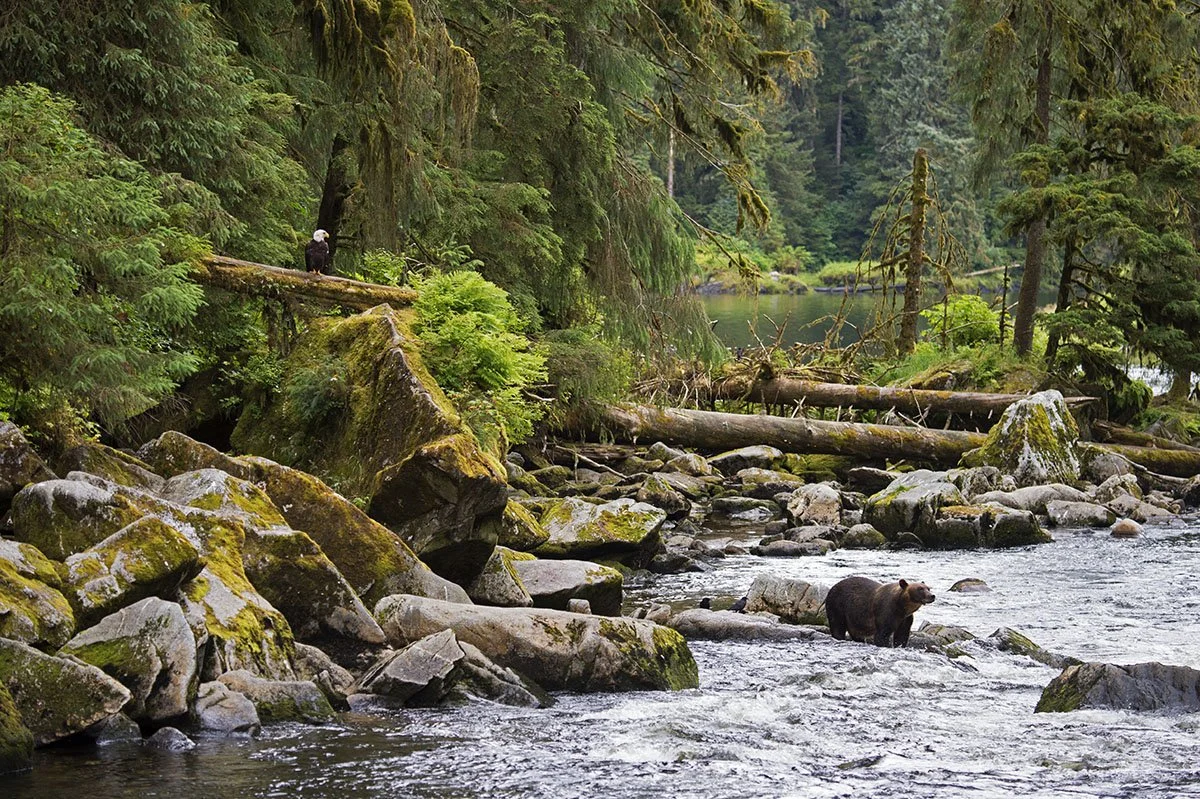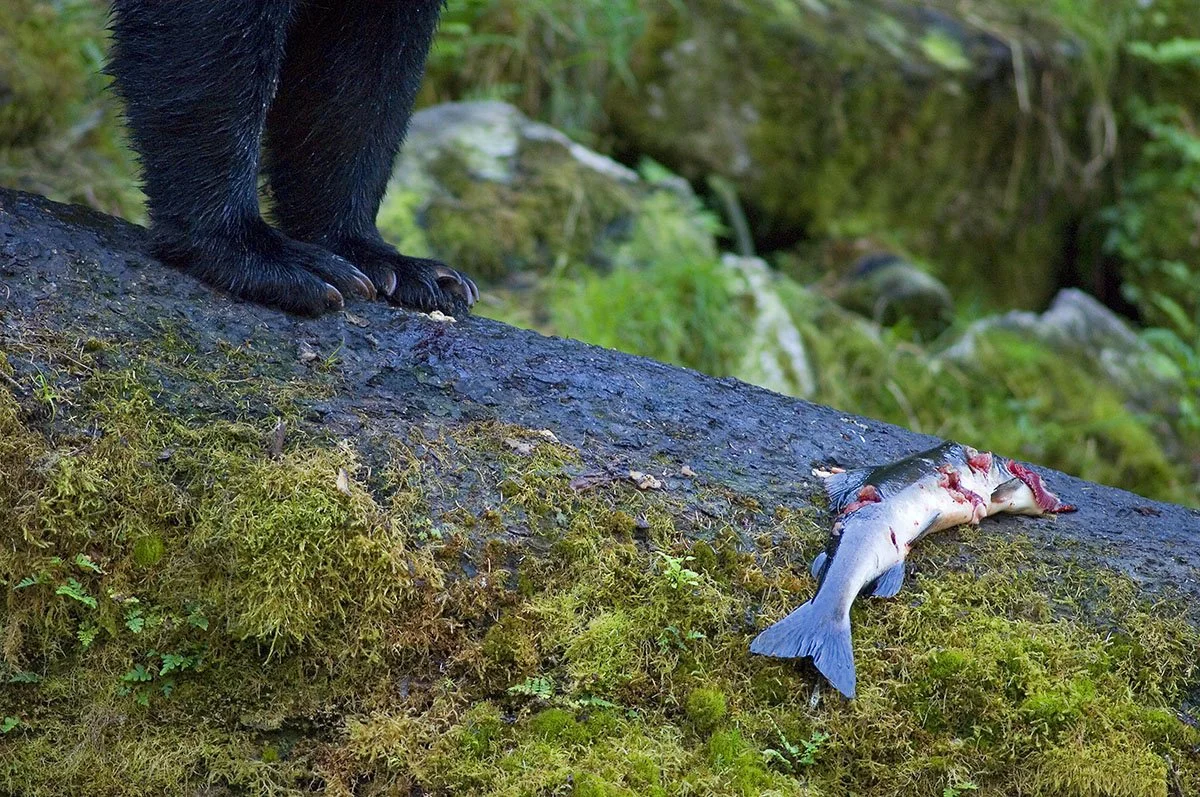Salmon in the Trees
In the Tongass, what goes around comes around
By Amy Gulick, Safina Center Senior Fellow
A Cool Forest | ©Amy Gulick/amygulick.com
Encompassing one-third of the world’s remaining old-growth coastal temperate rain forests, the Tongass National Forest is home to some of the world’s highest densities of both grizzly and black bears and the highest nesting density of bald eagles.
Take Action for the Tongass by January 24
In 2021, President Biden announced his intention to reinstate the Roadless Rule protections on nine million Tongass acres removed during the Trump Administration. But intentions will only be realized by holding the Administration’s feet to the forest floor. The official comment period to make your voice heard for the Tongass is January 24. Submit your comments today to ensure that the Tongass will always be a place where there are salmon in the trees.
Submit comments here: https://secure.alaskawild.org/a/roadlesstongass
Crouched on a rock near a churning waterfall, I’m entranced by thousands of salmon thronging in a pool. Fin to fin, tail to tail, they sway against the current as one giant mob, like concert groupies in a mosh pit. I forget that they are individual fish until one springs from the crowded stream, hurling itself against the foaming wall of water. And then another, and another. Fish after fish, leap after leap, so much energy expended, so much energy delivered. The long green arms of Sitka spruce and hemlock trees spread across the stream as if to welcome the salmon back into their forested fold. Click, click, click goes my camera in a frenzied attempt to freeze an airborne fish in my frame. They’re fast, much faster than my reflexes. I try again, and again. Hours vaporize, like the mist rising into the forest from the spray of the waterfall. But for the salmon every minute is precious because their time is coming to an end. They’ve stopped eating. They’re in their final act—spawning—and they won’t stop pushing upstream until they die. Their instinctive drive to pass on their genes is hammered home to me with every leaping fish. Click, click—lots of empty frames. I need to concentrate, but the distractions are many, and wonderful. The harpy screams of ravens emanating from the forest jolt my soul. Bald eagles swoop from treetops to rock tops, eyeballing the feast before them. Bears march into the stream with purpose, causing me to stand at attention. They know I’m here, but they seem focused on the fish at hand, or at paw. With one eye pressed against the viewfinder, and one eye open for bears, I attempt to focus on anything but instead just bask in the present. I’ve never felt more alive. It’s like I’m swirling in the middle of a wild performance with throbbing music, leaping dancers, and flashing lights. I have a front row seat to one of the greatest shows on Earth, one that plays out every year all over the Tongass National Forest in Southeast Alaska.
Just a few days before, there wasn’t a single salmon in this stream. In a few weeks, the only visible evidence of what took place here will be spawned-out carcasses littering the streambanks. The cleanup crews of birds, otters, and mink will scour the remains. Heavy fall rains will wash the fish bones out to sea, and bears will curl up in their dens as snow dusts the mountaintops. The show will be over, but the annual payout is rich. Bald eagles, fueled by salmon, will soar greater distances to find food during the lean winter months. Female bears, padded with fat reserves, will give birth in their dens and nurse their tiny cubs with salmon-enriched milk. The forest, fertilized with supercharged soil from decayed fish, will sprout new growth come spring. And the salmon? Those who survived their time in the ocean, dodged the hooks, nets, beaks, and jaws of predators, and returned to their birth streams to spawn and die are still here. These salmon live on in frolicking spring cubs, plump blueberries, new growth rings in tree trunks, and downy eaglets perched in their nests. And the next generation of salmon is swaddled in the streams and incubated by the forest. The fertilized eggs will soon hatch, ensuring that the cycle of life is a circle, always flowing, never broken. What goes around comes around.
A Salmon Forest | ©Amy Gulick/amygulick.com
Every year, millions of wild salmon infuse an upstream flow of nutrients into nearly 5,000 spawning streams throughout the Tongass National Forest. In return, the forest plays an important role in the life cycle of salmon. Trees shade the spawning streams, keeping the water temperatures cool for the developing eggs. Trees also prevent erosion from fouling the clean water and gravel beds the salmon need to lay their eggs. And fallen trees over the streams create protected pools for the juvenile fish and provide food for the insects they eat.
The Tongass National Forest boasts nearly a third of all that remains of the planet’s rare old-growth temperate rain forests, making it a world as well as national treasure. Rarer still is that all of the pieces are here – ancient forests, wild salmon, grizzly bears, wolves, Steller sea lions, humpback whales, and more. The circle is whole. And we are part of it too, not strangers on the outside looking in. The Tongass is a place where people live with salmon in their streets and bears in their backyards. It’s a land of remarkable contrasts. One of the world’s largest densities of brown bears is twenty minutes by floatplane from the Internet cafes and 30,000 residents of Juneau, the state capital of Alaska. Cruise ships carrying more than 2,000 passengers ply the same waters as mom-and-pop fishermen. That the modern world has arrived, and hasn’t yet broken the circle of life in the twenty-first-century Tongass is nothing short of astounding. But we’re on our way to carving up this extraordinary forest and it may just be a matter of time. We only have to look south to the once-magnificent salmon rain forests of Washington, Oregon and northern California to see how quickly we can decimate ancient trees, wild salmon, and a rich way of life.
Not too long ago, we thought we could improve upon what nature had perfected. We put bounties on bald eagles and Dolly Varden trout, thinking we were helping salmon by killing their predators. We tidied and straightened salmon streams, not realizing that nature’s chaos nurtures life. We built fish hatcheries and treated salmon like commodities instead of fine-tuned creatures that have carried their genetic message for millennia. We clear-cut ancient forests, not heeding the wisdom written in all those growth rings of trees many centuries older than us. We did all of this with the best of intentions, thinking we were doing the salmon, forests, and ourselves a favor. We know better today. That scientists have discovered salmon in the trees tells us that everything is connected. And if we start tossing away the pieces, we eventually unravel the whole glorious show. Salmon link the land to the sea and they can’t survive if both aren’t healthy. Neither can we. Long ago, we knew how to live within nature’s constraints. Deep down, I think we still do. We need the Tongass, if for no other reason than to connect us to the world as we once knew ourselves. When the circle is whole, so are we.
Salmon in the Trees | ©Amy Gulick/amygulick.com
In the Tongass National Forest, some of the world’s highest densities of grizzly and black bears transfer great quantities of salmon from streams to the forest. Loaded with ocean nutrients from their time at sea, the bodies of salmon decompose into the soil and the trees absorb the nutrients through their roots.
We’ve been given a great gift, and an even greater responsibility. The Tongass is public land that belongs to all Americans. All the pieces are still here. But for how long? The biological riches of the Tongass are vulnerable to the world’s demand for minerals, timber, seafood, tourist destinations, and who knows what else down the road. Yet despite these threats, I have hope. I think we can get it right in the Tongass simply because there’s still time to do so and we know it’s the right thing to do. This is our time. Let us learn from the lessons that salmon in the trees teach us and ensure that the greatest show on Earth goes on.
Amy Gulick is a photographer/author and Safina Center Fellow. Her award-winning books include: The Salmon Way: An Alaska State of Mind and Salmon in the Trees: Life in Alaska’s Tongass Rain Forest. Visit www.amygulick.com.



